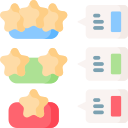Best Online UX/UI Design Courses Reviewed: Build Skills, Confidence, and a Portfolio That Matters
Chosen theme: Best Online UX/UI Design Courses Reviewed. Dive into a clear, friendly guide that blends real learner stories, practical evaluation criteria, and insight into which programs truly help you design, prototype, and present work that earns interviews.
Curriculum Depth and Relevance
We favor courses that stay current with research methods, Figma workflows, accessibility, design systems, and cross-platform patterns. If a syllabus includes measurable practice and real critique, it likely supports lasting growth. Comment with syllabi you want us to dissect.
Real Projects and Portfolio Credibility
Strong programs guide you from problem framing to tested prototypes, with stakeholder-style presentations and explicit learning outcomes. We seek projects that simulate constraints, user feedback, and metrics. Share your capstones; we may feature a breakdown in a future post.
Mentorship, Community, and Feedback Loops
Mentorship matters as much as modules. We rate programs higher when critiques are timely, specific, and repeatable. Active peer communities, office hours, and structured feedback cycles are green flags. Tell us how you prefer feedback: async notes or live sessions?

True Beginner Roadmaps
If you are new, look for structured intros that balance theory with guided labs: research basics, wireframes, usability tests, and short iterative sprints. Templates help, but reflection journals help more. Message us your learning timeline for tailored tips.
Intermediate Builders
Already ship UI but want product-level thinking? Seek courses emphasizing problem statements, KPIs, experimentation, and collaborative rituals. Realistic constraints and cross-functional exercises improve decision-making. Comment with skills you want to deepen next quarter.
Career-Change Accelerators
Switching careers needs portfolio storytelling, mentorship, mock interviews, and case studies with measurable impact. Programs with career services and alumni networks can shorten the path. Share your background; we will suggest modules that leverage your prior strengths.
Platform Snapshots: Coursera, Udemy, and Interaction Design Foundation
Coursera often pairs academic rigor with accessible pacing. You get structured sequences, peer reviews, and recognized certificates. Expect steady quizzes, practical assignments, and capstones. Tell us which specializations felt most hands-on versus primarily lecture-driven.

Platform Snapshots: Coursera, Udemy, and Interaction Design Foundation
Udemy excels in tactical, focused modules taught by practitioners. Great for leveling specific skills like advanced prototyping or visual systems. Check recency and student projects. Share courses that helped you break through a tricky technique or workflow bottleneck.
Skills That Stick: What the Best Courses Actually Teach
User Research That Drives Decisions
Great courses teach lightweight, repeatable research: interviews, surveys, competitive scans, and usability tests with clear protocols. They connect findings to prioritization and KPIs. Post your research hurdles; we will share field-tested tactics and scripts.
From Wireframes to High-Fidelity Prototypes
You should practice multiple fidelity levels, from sketches to interactive prototypes with realistic content. The best modules enforce iteration cycles and usability checkpoints. Which prototyping challenges slow you down? Tell us and we will gather targeted exercises.
Accessibility and Inclusive Design as Standards
Strong programs embed accessibility from day one: contrast checks, keyboard navigation, semantic structure, and cognitive load. Inclusion is quality, not an add-on. Share your accessibility wins or blockers; we will compile resources and office-hour sessions.
Projects That Impress Recruiters: Case Studies with Measurable Impact
Effective portfolios frame a real problem, constraints, and success metrics. They show options explored, trade-offs, and learnings. Ask your course to provide critique rubrics. Want feedback on a draft? Drop a link and we will share narrative pointers.


Aisha: From Hospitality to Product Design
Aisha balanced shifts with nightly sprints, leaning on mentor critiques to compress her learning curve. Her first case study emphasized accessibility improvements that raised task completion for screen reader users. She invites your questions about time-management hacks.

Marco: Leveling Up Inside His Company
Marco used an intermediate course to formalize discovery and metrics. He led a cross-team test that reduced onboarding friction for new users. His tip: schedule research like a recurring meeting. Ask him about stakeholder alignment templates.

Define Outcomes and Constraints
Clarify your job target, available hours, budget boundaries, and timeline to first interview. This filters noise fast. Drop your constraints in the comments, and we will reply with a tailored shortlist you can compare this week.

Audit Syllabi, Samples, and Community
Scan modules, watch sample lessons, and read project briefs. Look for critique cadence, rubrics, and alumni examples. Join a forum to gauge responsiveness. Share screenshots of syllabi you are weighing for quick, friendly feedback.

Engage With Us: Ask, Subscribe, Participate
Post your top two options and specific concerns. Subscribe for our upcoming deep dives on portfolios and research plans. Vote on which course we should analyze next, and invite a friend starting their UX/UI journey.
